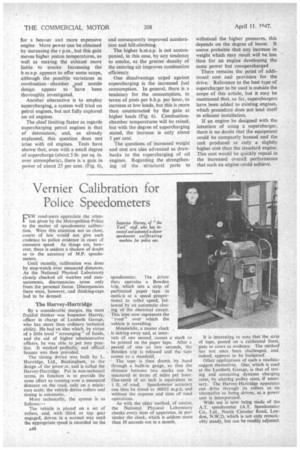Vernier Calibration for Police Speedometers
Page 42

If you've noticed an error in this article please click here to report it so we can fix it.
FEW road-users appreciate the attenton given by the Metropolitan Police to the matter of speedometer calibration. Were this attention not so close, courts of law would not give such credence to police evidence in cases of excessive speed. As things are, however, there is seldom a shadow of doubt as to the accuracy of M.P. speedometers.
Until recently, calibration was done by stop-watch over measured distances. As the National Physical Laboratory closely checked all watches and measurements, discrepancies arose only from the personal factor. Discrepancies there were, however, and thinking-caps had to be donned.
The Harvey-Hartridge
By a considerable margin, the most fruitful thinker was Inspector Harvey, officer in charge of Lambeth Garage, who has more than ordinary technical ability. He had an idea which, by virtue of a little local " scrounging" of funds, and the aid of higher administrative officers, he was able to put into practice. It worked perfectly; and official finance was then provided.
The timing device was built by L. Hartridge, Ltd., Buckingham, to the design of the inven'or, and is called the Harvey-Hartridge. Put in non-technical terms, its function is to provide the same effect as running over a measured distance on the road, only on a miniature scale; the vehicle drives rollers and timing is automatic.
More technically, the system is as follows:— The vehicle is placed on a set of rollers, and, with third or top gear engaged, driven in a normal way until the appropriate speed is recorded on the
speedometer. The driver thel operates a Bowden trip, which sets a strip of perforated paper tape in motic n at a speed proportional to roller speed, followed by an automatic closing of the electrical circuit. This tape now represents the road" over which the vehicle is travelling.
Meanwhile, a master clock is ticking away and, at intervals of one second, causes a mark to be printed on the paper tape. After a period of one or two seconds, the Bowden trip is released and the tape comes to a standstill.
The tape is then drawn by hand through a built-in gauge, so that the distance between two marks can be measured in terms of miles per hour. One-tenth of an inch is equivalent to 1 ft. of road. Speedometer accuracy can thus be timed to .00035 m.p.h. and without the expense and time of road operations.
As with the older method, of course, the National Physical Laboratory checks every item of apparatus, in particular the clock, which is seldom more than 10 seconds out in a month.
It is interesting to note that the strip of tape, pasted on a calibrated form. goes to court as evidence. The method has not once been challenged, and, indeed, appears to he foolproof. Other applications of such a machine suggest themselves. One, which is used at the Lambeth Garage, is that of testing and correcting dynamo charging rates, by altering pulley sizes, if necessary. The Harvey-Hartridge apparatus can drive through its rollers as an alternative to being driven, as a power unit is incorporated.
Wide use is now being made of the A.T. speedometer (AT. Speedometer Co., Ltd. North Circular Road, London, N.W.2), which is not only remarkably steady, but can be readily adjusted.




































































